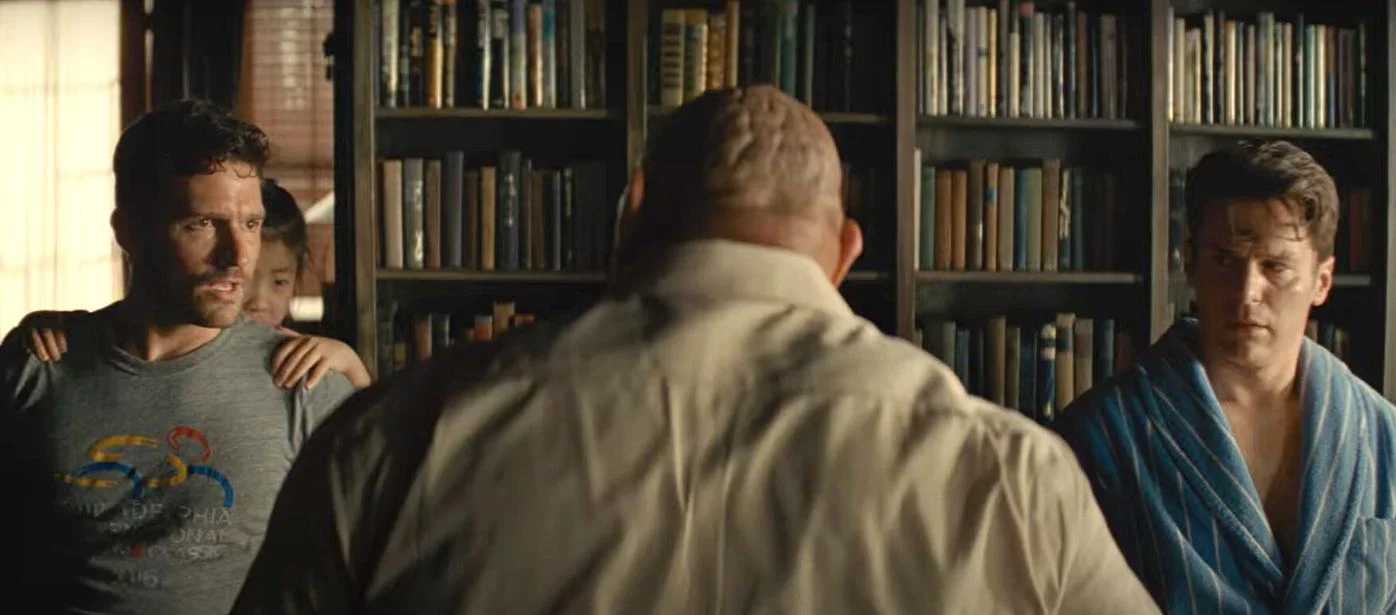
Director M. Night Shyamalan returns to the big screen with his latest film Knock at the Cabin. While couple Andrew (Ben Aldridge) and Eric (Jonathan Groff) are vacationing at a remote cabin in the woods with their young daughter Wen (Kristen Cui), she is approached while outdoors collecting grasshoppers by Leonard (Dave Bautista), a polite but imposing man who attempts to befriend her. Leonard is soon joined by three armed strangers, Redmond (Rupert Grint), Adriane (Abby Quinn), and Sabrina (Nikki Amuka-Bird). The foursome soon breaks into the family’s cabin and takes them hostage who explain they are there to present them with an unthinkable choice: the family must choose one of its members to sacrifice in order to avert the coming apocalypse.
Knock at the Cabin is a dense thriller that establishes and builds its tension and suspense extremely well from almost the very first shot of the film. Leonard arrives onscreen with a tender yet worrying conversation with Wen; an imposing adult stranger trying to establish a connection with a young child who is outdoors alone. The tender discussion the two have about their lives and grasshoppers with the underlying sense of danger sets the foreboding atmosphere that lasts throughout its runtime. This sense of dread is buoyed by the incredible camerawork utilized by Shyamalan and his directors of photography Jarin Blaschke and Lowell Meyer featuring dynamic movement and scene transitions that allow a film that mostly takes place on one set in the living room of a cabin and allows it to feel expansive and larger than it really is. The also use what has colloquially become known as the “Jonathan Demme closeup” that was famously utilized by the director in 1991’s Silence of the Lambs. The filming technique that centers the faces of the actors in the frame and directs their glance directly into the camera has the effect of transporting the audience directly into the film allowing us to feel the tension and fear and emotions that the characters do as if they are experiencing the story alongside them. Shyamalan, Blaschke, and Meyer take the Demme closeup a step further however and employ it on Leonard and Wen using the dutch angle to visually emphasize that not all is on the straight and narrow. The visual language of this film is used well in strengthening its narrative.
Thematically, Knock at the Cabin explores substantial questions surrounding sacrifice, forgiveness, and human nature. As Andrew and Eric wrestle with the impossible and unbelievable choice that is thrust upon them, Shyamalan skillfully interweaves the same sex couple’s backstory through flashbacks showing their struggles with being accepted by family, international adoption agencies, and society writ large as they try to fortify and expand their family. As the main narrative unfolds and their family of three is terrorized and the four home invaders’ claims slowly reveal their truth, or lack thereof, we see how this chosen family’s past experiences affect their outlook on being willing to sacrifice for the good of humanity as a whole, Andrew in particular. Why should they give their lives for those who made theirs difficult for simply being who they are? Are such people worth an innocent life being sacrificed? Andrew and Eric wrestle with this question, and the question of whether that sacrifice is worth it not for humanity itself but for a loved one in a well acted scene between Aldridge and Groff. The questions of whether humans deserve to be forgiven for their flaws and cruelty or whether you would do so for the benefit of your loved ones is a emotional through line that works as a result of how Shyamalan lays out the story of both Andrew and Eric’s journey as a couple and the present terror they experience in the cabin.
Knock at the Cabin is a psychological horror thriller that grabs its audience from the outset and engulfs it in dread from beginning to end. The film may feature the most impressive cinematography in an M. Night Shyamalan film yet and while it doesn’t employ one of his now signature twists, the theme of its narrative is an interesting one that may also pull in some who have grown to dislike his surprise endings. The ensemble in the film works together well as a whole, with Aldridge, Groff, and Cui fully encapsulating the loving family dynamic and Bautista, Grint, Quinn, and Amuka-Bird skillfully portraying a group of people who believe what they are saying, display the requisite range of emotions of their actions from fear to regret to frustration, while toeing the line of are they crazy or are they being truthful? It’s one of the engines on which the film is running and they accomplish making it believable. This was an entertaining watch that won’t make one regret taking the time to support it.
Image: Universal Pictures

